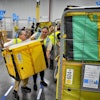SIOUX FALLS, S.D. (AP) -- The American Wind Energy Association is developing a seal of approval for community colleges and technical schools that train wind turbine service technicians.
More technicians will be needed for the growing U.S. industry, which installed more than 10,000 megawatts of projects in 2009 and now provides 1.8 percent of the nation's power, according to recent trade group report.
North Dakota surpassed a gigawatt of capacity in 2009 to reach 1,203 megawatts, while South Dakota grew to 313 megawatts of capacity and Nebraska to 153 megawatts, AWEA said.
To keep pace, the industry wants to establish a minimum basic skill set that technicians are expected to have on their first day on the job. Programs meeting requirements developed by the association will get a thumbs-up.
"They will go to each of the institutions and review their curriculum and their programs, and if they are providing that set of skills as a minimum, then that college will receive an AWEA stamp of approval," said Susan Wolff, chief academic officer at Columbia Gorge Community College in The Dalles, Ore.
Wind technicians need a diverse skill set, drawing from the fields of electrical engineering, mechanical engineering, hydraulics, programmable logic controllers and metals, said Tracy Rascoe, wind energy technology director for the Northwest Renewable Energy Institute in Vancouver, Wash.
A service tech in any industry gets a work order, gathers tools and drives out to a job, but wind turbine technicians have to climb 200 feet in the air before they can get to work.
"You get out there and you have this huge piece of rotating equipment with power and exposure of the elements," said Rascoe, a team leader for AWEA's community college and technical school education work group. "I've worked in -22 degrees, not counting wind chill, up to 120 degrees, and everywhere in between."
That's why safety is such an important competence for students to master.
"This is kind of a dangerous occupation," said Iowa Lakes Community College's Darin Moeller. "You're working 200 feet up in the air. You're dealing with high voltage that has its risks involved."
Iowa Lakes established one of the country's first community college wind technician programs with 15 students in 2004. The school was thinking of installing a turbine to save on utility costs when administrators learned of the industry's need for trained technicians, said Moeller, executive dean of the Iowa Lakes Estherville Campus.
The program has since grown to accept 102 new students each fall.
Some students earn a one-year certificate, while most will stay for a second year to get an associate of applied science degree. Graduates can earn $35,000 to $40,000 in an entry-level position, Moeller said.
AWEA estimates that one wind technician is needed to service every 10 megawatts of installed wind generating capacity. That translates to 700 new wind technicians needed in 2009 to keep pace with new wind farm installations.
The worldwide recession slowed some of the industry's fast growth, but that need is not going away, Moeller said.
"The long-term need for technicians appears to be there," he said. "We're just in a little bit of a slump right now with some hiring, probably just because of the economy."
In the summer of 2008, Columbia Gorge hosted a meeting of 18 colleges and universities, seven wind companies and AWEA staff members to come up with a draft set of skills. The guidelines will be completed this year.
Educational and industry leaders decided to go with a seal of approval at this stage rather than a national certification program.
"Each one of the companies has to train those new employees anyway to the very turbine-specific things that are of a propriety nature that we can't be teaching," Wolff said. "So they didn't feel that a national certification was quite needed yet."
Technology in the industry changes fast.
Columbia Gorge started its wind technician training program in the fall of 2007, and it's already looking at the fourth major change of its curriculum, Wolff said.
Iowa Lakes also has needed to adjust its program over time.
"It's one of those changing technologies that if you're standing still, you're probably falling behind," Moeller said.


















